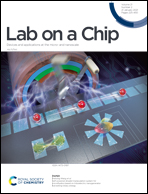A microfluidic cathodic photoelectrochemical biosensor chip for the targeted detection of cytokeratin 19 fragments 21-1†
Abstract
A microfluidic chip integrated with a microelectrode and a cathodic photoelectrochemical (PEC) biosensor for the ultrasensitive detection of non-small cell lung cancer cytokeratin fragments based on a signal amplification strategy was designed. The mechanism for signal amplification is developed based on the p–n junction of AgI/Bi2Ga4O9, with dissolved O2 as an electron acceptor to produce the superoxide anion radical (˙O2−) as the working microelectrode. By combining this with a novel superoxide-dismutase-loaded honeycomb manganese oxide nanostructure (SOD@hMnO2) as the co-catalyst signal amplification label, ˙O2− can be catalyzed by SOD via a disproportionation reaction to produce O2 and H2O2; then, hMnO2 is able to trigger the decomposition of H2O2 to generate O2 and H2O. Therefore, the increased O2 promotes the separation of electron–hole pairs via consuming more electrons, leading to an effective enhancement of the cathodic PEC behavior. Under optimum conditions, with the cytokeratin 19 fragments 21-1 (CYFRA 21-1) as the targeted detection objects, the microfluidic cathodic PEC biosensor chip exhibited excellent linearity from 0.1 pg mL−1 to 100 ng mL−1, with a detection limit of 0.026 pg mL−1 (S/N = 3). The exciting thing that this work offers is a new strategy for the detection of other important cancer biomarkers for disease diagnosis and prognosis.



 Please wait while we load your content...
Please wait while we load your content...